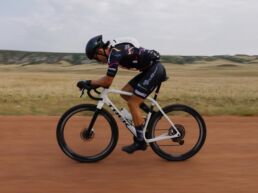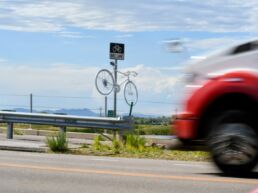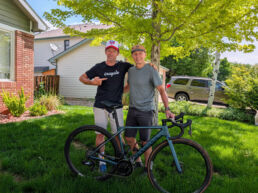A brief background on Megan, who answers my questions below:
Megan is “TheCyclist-Lawyer,” she almost exclusively represents cyclists in her practice, which is based in Golden. Prior to starting her own firm, she worked for 2 judges, one  in Kansas City and one in Golden at the Jefferson County District Court. As a law clerk she was directly involved in jury trials, including serving as the jury bailiff. She observed first hand good lawyering, bad lawyering, juror interpretations of cases, the judges’ opinions and legal research on the issues, and of course, the jury findings in those cases. She’s handled over 50 cycling cases in just 4 years and as part of her representation in the civil case on the cyclist’s behalf, she also represents the cyclist in the traffic/criminal case pending against the at-fault driver (or sometimes the cyclist is the one cited, and she defends the ticket they are issued). Megan has seen all sides of the cycling issues in the civil and criminal realms here in Colorado and I asked her to shed some light on the plea deal announced in the Coloradaon in the case of Theresa Marie O’Connor, the driver who hit (and killed) Ernesto Wiedenbrug, and then fled the scene.
in Kansas City and one in Golden at the Jefferson County District Court. As a law clerk she was directly involved in jury trials, including serving as the jury bailiff. She observed first hand good lawyering, bad lawyering, juror interpretations of cases, the judges’ opinions and legal research on the issues, and of course, the jury findings in those cases. She’s handled over 50 cycling cases in just 4 years and as part of her representation in the civil case on the cyclist’s behalf, she also represents the cyclist in the traffic/criminal case pending against the at-fault driver (or sometimes the cyclist is the one cited, and she defends the ticket they are issued). Megan has seen all sides of the cycling issues in the civil and criminal realms here in Colorado and I asked her to shed some light on the plea deal announced in the Coloradaon in the case of Theresa Marie O’Connor, the driver who hit (and killed) Ernesto Wiedenbrug, and then fled the scene.
Q: Let’s cut straight to the chase –why isn’t the DA taking this case to trial instead of offering a plea deal to the driver?
A: Every defendant charged in traffic or criminal cases has 2 options: plead guilty, and accept the court’s sentence based on recommendations made by the DA and your lawyer (either a public defender, a private attorney if you hired one, or your own statements if you are pro se); or, plead not guilty and the case is set for trial.
As we just saw in the Valmont Road bicyclist death case in Boulder, juries don’t do what we always think they will –or should. One unique aspect to cycling cases, whether in criminal trials or civil trials, is a jury bias, which is that jurors more often identify with the driver than they do with the cyclist. In other words, they see themselves sitting in the accused’s chair in the courtroom because they think to themselves, “I drive a car, I see cyclists darting around all the time, I could accidentally hit one and be sitting right there, charged for ___ or facing $___ in civil damages.” Even assuming you get all the anti-cycling folks off the jury panel, there will be several who sympathize more with the at-fault driver than they do with the cyclist. Many folks can’t relate with cyclists-they don’t understand why a person would choose to ride a bike when a perfectly-functioning car sits in their driveway. (Side note- when I commuted to work in downtown Kansas City, MO, people asked me all the time: “Why’d you ride, is your car in the shop?” To them, it seemed so odd that a person would ride instead of drive).
Not only is there this jury bias issue, but DA file loads are overwhelming. They literally have hundreds of open files at a time. If a defendant expresses interest or willingness to accept a plea agreement, the DA’s office has incentive to accept the plea. It allows them to get a sentence in a case and to close the file. They work long days and often weekends with no end in sight to their caseload. Sadly, the system is set up in such a way that they simply cannot invest themselves in every single case. And in my own experience -being involved in my own clients’ criminal/traffic cases (Where they were the victim, hit and injured by the defendant-driver) – for some reason the “baby-DAs” – i.e., the young lawyers in the offices –are often assigned to these cycling cases). You would think a seriously bodily injury case or especially a death case would warrant the attention of a more senior lawyer in the DA’s office but that isn’t usually the case. I presume there is some sort of file assignment procedure where the most serious crimes are assigned to the most senior lawyers but I would only be guessing.
What you ultimately end up with then, is a younger, less experienced DA handling these biking cases, with a desk overflowing with case files, and serious incentive to accept a plea deal instead of forcing a case to trial where they may very well lose –whether due to their own inexperience or due to juror bias or jurors not liking cyclists.
Q: If juror bias is such an issue in these cases, why not be sure that all anti-cycling jurors are removed from the trial?
A: People assume jury selection (voir dire) offers the attorneys ample opportunity to sniff out juror biases and remove any that may express anti-cyclist sentiment. But it’s not so simple. Often each side has only 30 minutes to make inquiries of the panel, and other issues such as willingness to follow instructions, and understanding that a person is innocent until proven guilty, pervade the majority of the questions. There’s also the issue of jurors remaining silent or misrepresenting their opinions. A lawyer may point-blank ask a panel: how many of you don’t cyclists? And perhaps none raise their hands, even though half are sitting there thinking it. Therein lies the challenge of jury trial. You never know what you will get with a jury.
By way of example – I recently observed a mock trial (CLE for lawyers) where real evidence was presented by really good lawyers and a jury of random volunteers heard the evidence and then deliberated (on video, so we could see it). It was a failure to yield case involving 2 cars (note: this is one of the most common car-bike collisions, where a car turns left in front of an oncoming cyclist). The plaintiff was proceeding straight through an intersection on a green-turned- yellow light. The defendant was coming from the opposite direction, had a green (but not green arrow) and was obligated to yield to oncoming traffic before making the left. Despite this, he proceeded to make his turn directly in front of the oncoming car and there was a massive collision. Both drivers were seriously injured. The plaintiff sued the defendant who turned left in front of her (of course his insurance company, defended the claims). Everyone in the room was more or less in agreement that the man who failed to yield was at fault –it was a matter of how much the Plaintiff’s damages were. Right?
Imagine our surprise as we watched the jury deliberate. They said things like “she should have stopped when she saw him turning in front of her…” And as their deliberations continued, the roomful of lawyers became incredulous. The jury came back with a verdict of 70-30, meaning they found the Plaintiff (the woman going straight on her green-turned-yellow) 70% at fault, and the guy who turned in front of her 30% at fault. In Colorado a finding that the plaintiff is over half at fault results in a $0 verdict for her. So she got nothing. This is what juries can do. They don’t always follow the judge’s instructions. They sometimes focus on some small bit of evidence that wasn’t significant to the case. They sometimes fixate on something that was never mentioned and they wish they knew more about it. Taking cases to trial means that in effect you roll the dice. Juries are unpredictable.
Q: why don’t DAs charge more seriously in these cases? It seems like we see “Careless driving” all the time. Why don’t we see vehicular manslaughter or similar felony-level charges?
A: In my experience in these cases, I find that the charges really all stem from the police officer’s initial investigation at the scene –witness statements, photos, measurements, and assessments of fault. DAs can always add or subtract charges as their investigation reveals new information. But by and large, the charges flow from the officer’s original citation or conclusions of fault.
After that, it becomes a function of the elements of each charge and what a DA thinks they can prove at trial. Each crime has specific elements which must all be proven. For example the statute defines Careless driving as:
§ 4241402. Careless drivingpenalty
(1) A person who drives a motor vehicle… in a careless and imprudent manner, without due regard for the width, grade, curves, corners, traffic, and use of the streets and highways and all other attendant circumstances, is guilty ofcareless driving.
(2)(a) Except as otherwise provided in paragraphs (b) and (c) of this subsection (2), any person who violates any provision of this section commits a class 2 misdemeanor traffic offense.
(b) If the person’s actions are the proximate cause of bodily injury to another, such person commits a class 1 misdemeanor traffic offense.
(c) If the person’s actions are the proximate cause of death to another, such person commits a class 1 misdemeanor traffic offense.
Careless means just that – imprudent, without due regard. There is no intent component. They did not mean to cause harm, they were being careless.
I represented a cyclist last year who was struck when a motorist approached a group of cyclists from behind, began laying on his horn, driving aggressively and sure enough, clipped my client and hooked him under the front passenger car tire. We don’t believe he actually meant to hit a rider, but his conduct was clearly intended to be harassing and menacing. In that case, the Jefferson County DA charged Carless Driving causing serious bodily injury. She did not feel she could prove intent, which would have been an element of more serious charges.
Each charge or crime has a specific Colorado Criminal jury instruction, which sets forth the elements, and burden of proof. Here is the instruction a jury would be given to follow on a reckless driving charge:
42:07 RECKLESS DRIVING
The elements of reckless driving are:
1. That the defendant,
2. in the state of Colorado, at or about the date and place charged,
3. drove a [motor vehicle] [bicycle] [motorized bicycle],
4. in such a manner as to indicate either a wanton or a willful disregard for the safety of persons or property,
5. [without the affirmative defense in instruction number _______.]
After considering all the evidence, if you decide the prosecution has proven each of the elements beyond a reasonable doubt, you should find the defendant guilty of reckless driving.
After considering all the evidence, if you decide the prosecution has failed to prove any one or more of the elements beyond a reasonable doubt, you should find the defendant not guilty of reckless driving.
*Note, other instructions given to the jury specifically define what willful and wonton means for purposes of this instruction.
Compare this to:
3-2:18 VEHICULAR ASSAULT
The elements of the crime of vehicular assault are:
1. That the defendant,
2. in the State of Colorado, at or about the date and place charged,
3. operated or drove a motor vehicle,
4. [in a reckless manner, and] -or- [while under the influence of [alcohol] [one or more drugs], or a combination of both alcohol and one or more drugs, and]
5. this conduct was the proximate cause of serious bodily injury to another person.
6. [without the affirmative defense in instruction number __________.]
After considering all the evidence, if you decide the prosecution has proven each of the elements beyond a reasonable doubt, you should find the defendant guilty of vehicular assault.
After considering all the evidence, if you decide the prosecution has failed to prove any one or more of the elements beyond a reasonable doubt, you should find the defendant not guilty of vehicular assault.
And finally –note the elements of Vehicular homicide:
3-1:13 VEHICULAR HOMICIDE
The elements of the crime of vehicular homicide are:
1. that the defendant,
2. in the State of Colorado, at or about the date and place charged,
3. operated or drove a motor vehicle
4. [in a reckless manner,] -or- [while under the influence of [alcohol] [one or more drugs] [a combination of both alcohol and one or more drugs],]
5. and such conduct was the proximate cause
6. of the death of another.
7. [without the affirmative defense in instruction number ________.]
After considering all the evidence, if you decide the prosecution has proven each of the elements beyond a reasonable doubt, you should find the defendant guilty of vehicular homicide.
After considering all the evidence, if you decide the prosecution has failed to prove any one or more of the elements beyond a reasonable doubt, you should find the defendant not guilty of vehicular homicide.
In summary, you would need to ask the Larimer DA in this specific case why they chose to charge what they charged and why the proposed plea is what it is. Perhaps the victim’s family was consulted and this was agreed upon, perhaps they were not and the DA’s office has other reasons. I would recommend contacting the attorney for the victim’s family (assuming there is one) for additional information regarding the plea discussions.
Q: You mentioned in a comment on YGR that insurance companies may not pay if an intentional crime is charged. Does this influence the DAs decision?
A: no absolutely not. The DA is prosecuting charges on behalf of the state of Colorado against a defendant. They do not care if the charges impact insurance payouts to crime victims. They charge what they think they can prove at trial and what they think is appropriate in a case. They have told me many times they don’t care what happens in the civil case.
That said, in my own clients’ cases, on the civil side we are 99% of the time pursuing the insurance company of the driver. (Side note: many people are judgmental of this – one YGR comment mentioned how it raises premiums for everyone. Please don’t have this mentality. We all buy insurance in case we are injured or we injure someone else. We are required to have insurance to drive our cars. Anymore, people are so bogged down in debt and own so few assets outright or so rarely have any real money in the bank, that suing a person individually is futile. It’s not worth the paper the judgment is written on. The way the world works is that you sue the driver’s insurer, and that insurer defends the civil lawsuit).
Insurance companies do not insure criminal acts. Therefore, if their driver is charged with an intentional crime, it is likely the insurance company will deny the injured cyclist’s claim for damages. The cyclist could then sue the driver personally (and the driver would potentially have a claim against his insurer for failing to defend him)… but again, suing a person who doesn’t have assets is pointless.
So, often times, it is beneficial to a cyclist’s civil case when a DA charges “careless driving” because this charge does not prompt the insurance to deny the claims. Among my clients, if asked, I think 100% of them would choose the insurance payout for their medical bills and lost wages, than “justice” in the criminal case by virtue of a harsher charge. Again –don’t judge until you’ve been in this position. Injured cyclists are often faced with hundreds of thousands of medical bills, lost wages, future medical expenses, their bike is toast, they can’t work, they’re in a lot of pain and their life is upside down as a result of the accident. Yes they want to see justice rendered by the DAs office. But they also want money for their bills and damages.
This is why, before cyclists decide to lambast DAs online in their comments, I recommend contacting the injured cyclist (or their family, if the cyclist is deceased) and inquire – what were your wishes? Because you may find that the DA was actually acting out the victim’s wishes. DAs care what victims want. In my clients’ cases I have found DAs in every jurisdiction along the front range to engage my client, to seek their approval of the proposed plea agreement, to see how they feel about it, and most importantly- they’ve given my clients a chance to address the court at sentencing. Alternatively in cases where the defendant has entered a not guilty plea and the case is set for trial, I have seen DAs spend extensive time and effort to prepare my client for the criminal trial, to prepare them for their testimony and to get ready to put on a good case to a jury.
The sentencing hearing is really where the healing and closure happens for my clients. This is when the cyclist gets to tell the judge how the accident totally screwed up their life. How their body, health, head, life will never be the same. And the judge cares. And then the judge usually lays into the driver and the cyclist gets to hear that and see the driver crying and upset and usually remorseful. This process is very powerful. In several cases, the driver has looked my client in the eye and apologized sincerely and this means more than anything to a cyclist who was injured by their negligence. When it was purely an accident. When the motorist didn’t mean to hit the cyclist. And you see the motorist struggling to live with the weight of what they’ve done. Knowing they forever altered another human being’s life. Living with the fact that they hit and injured – or killed, in the case of O’Connor, who caused Ernie’s death – will be something that haunts them every single day for the rest of their lives.
Long answer to your short question but I hope that provides some context.
Q: Ok, so according to the Coloradoan, a plea agreement has been reached between O’Connor and the DA’s office. What’s next?
A: Usually the plea will be proposed and entered at a “dispo” hearing. Depending on the charges and potential fines and penalties (judges have to obey sentencing guidelines, which provide minimums and maximum for each crime), a judge may set over the sentencing hearing for a later date, so that a pre-sentence investigation can be completed. This usually involves researching the defendant’s criminal history, driving record, their employment situation, family situation, etc. For example, if restitution to the victim is ordered, a judge may choose a sentence that allows the defendant to remain working, in the hopes the restitution will be paid. One reality of our criminal justice system is that the jails are over-crowded. Judges are encouraged to find other ways to render punishments in the cases where the defendant is a non-violent offender. In a careless driving case where the driver did not have prior offenses, it is very unusual for a judge to sentence them to any jail time. Jail is often reserved for the worst offenders. So –while I realize cyclists often want to see jail time ordered in cyclist –injury or death cases – from the judge’s perspective, they have lots of different factors to consider. In the O’Connor case, I recommend cyclists in Larimer County be sure to attend the sentencing hearing. So you can see the testimony offered by both sides and you can see the judge’s deliberation and ultimately rendering of the sentence. These hearings are often very emotional. Families of both sides often appear and address the Court. It is not as easy as you might think for a Judge to render sentences in these cases.
That said- in a case where a motorist hits a cyclist and leaves him for dead, and where her failure to call 911 arguably did contribute to his ultimate death, a harsher sentence is appropriate. She may have hit the cyclist accidentally, but she left the scene intentionally. And to me that crime warrants jail time. I hope the judge will make an example of O’Connor and will issue a harsh sentence, demonstrating that Larimer County does not tolerate drivers hitting cyclists and leaving them to die at the scene. Some time in a jail cell will give O’Connor time to reflect on the decision she made, which cost a man his life.
42:15 FAILURE TO GIVE NOTICE, INFORMATION, AND AID
The elements of the crime of failure to give notice, information, and aid are:
1. That the defendant,
2. in the State of Colorado, at or about the date and place charged,
3. being the driver of a vehicle,
4. knowingly and directly involved in an accident resulting in [injury to] [serious bodily injury to] [the death of] any person,
5. failed to immediately stop his vehicle at the scene of the accident or as close thereto as possible, and to forthwith return to the scene, and
6. give his name, address, and the registration number of the vehicle he was driving and exhibit his driver’s license upon request to the person struck, the driver of, an occupant of, or the person attending any vehicle collided with, and
7. render reasonable assistance, where practicable, to a person injured in such accident including carrying or arranging for the carrying of a person injured in such accident to a physician, surgeon or hospital for medical or surgical treatment if it was apparent that such treatment was necessary or if the carrying was requested by the injured person.
8. [without the affirmative defense in instruction number_______________.]
After considering all the evidence, if you decide the prosecution has proven each of the elements beyond a reasonable doubt, you should find the defendant guilty of failure to give notice, information and aid.
After considering all the evidence, if you decide the prosecution has failed to prove each of the elements beyond a reasonable doubt, you should find the defendant not guilty of failure to give notice, information and aid.






